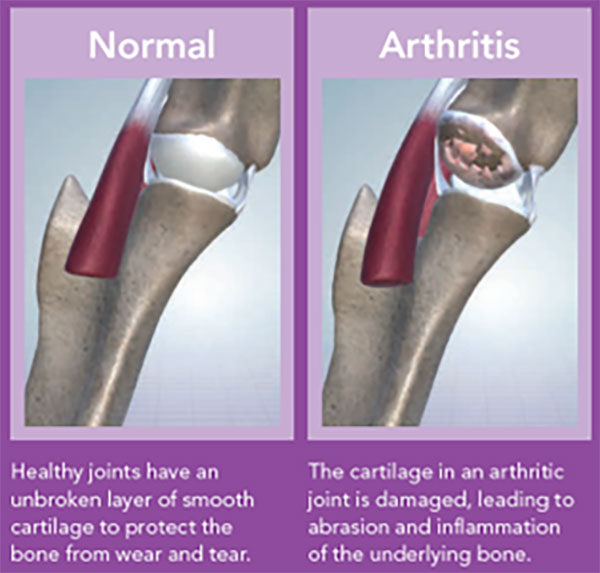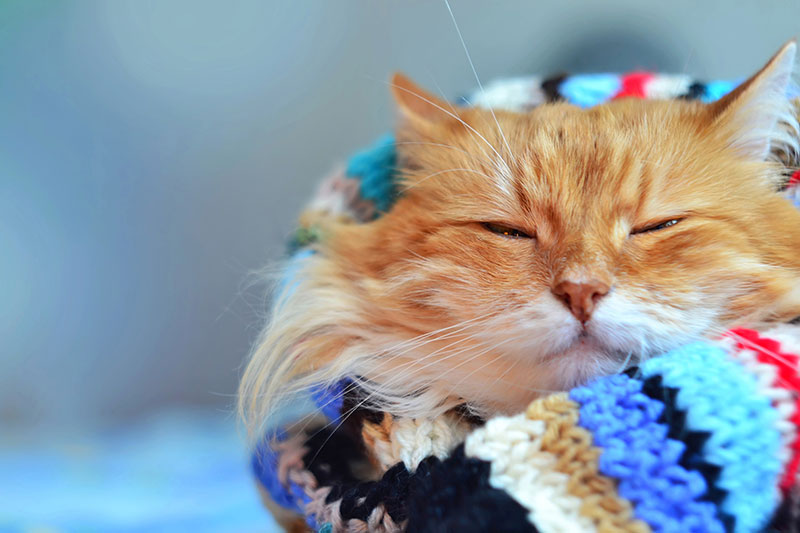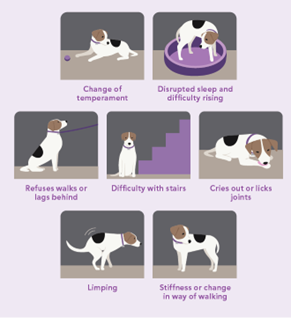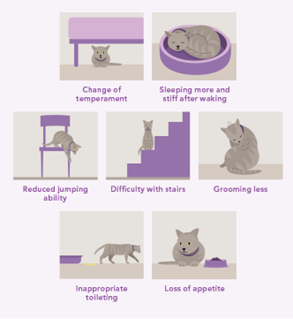What is osteoarthritis?
Osteoarthritis is a degenerative joint disease where the cartilage within the joint is worn away, leading to inflammation and pain. It is a common cause of impaired mobility in dogs and cats, and the signs are often incorrectly attributed to ‘slowing down due to the natural ageing process’, which means many pets are missing out on osteoarthritis treatments that could improve their quality of life.

The differences between cats and dogs
Osteoarthritis in dogs occurs primarily because of developmental orthopaedic disease, for example, hip or elbow dysplasia. Developmental diseases result in increased or abnormal mechanical loading in the joint which leads to chronic low-grade inflammation and degradation of joint tissues, and pain. For these reasons, osteoarthritis (and associated pain) develop early in life and should be considered a “young dog disease” despite being generally diagnosed in its later stages when the signs are easier to spot.
Although the mechanisms resulting in degenerative joint disease in cats are not fully understood, they are generally not related to developmental disease as they are in dogs. In cats, as with humans, osteoarthritis can be considered an age-related disease and is more prevalent as cats age. However, young cats can also be affected. Trauma is also an important risk factor for cats, especially those with outdoor access.


Recognise the subtle signs
Dogs and cats can be quite effective at hiding their pain which makes it difficult to recognise osteoarthritis in its early stages. However, it is very important for long-term joint health that action is taken as early as possible. If you recognise any of the behavioural signs in the image in your pet, there’s a good chance that they may be suffering from osteoarthritic pain.
If you’ve noticed any of the above behaviours, your pet may be in pain and it is best to contact your vet. Try to capture some video footage as it can be very helpful for your vet to see video evidence of the behavioural signs you have noticed at home.
Osteoarthritis is a lifelong condition that requires a combination of attentive home care and veterinary care.
One of the main goals of treatment of OA is managing the pain and inflammation it is associated with. Be sure to discuss this with your vet to determine the best course of action. Early diagnosis, treatment and regular check-ups can help your pet rediscover their youthful enthusiasm.

References
- Monteiro, B. P. et al. (2022) 2022 WSAVA guidelines for the recognition, assessment and treatment of pain. J Small Anim Pract,.
- Maniaki, E. et al. (2021) Associations between early neutering, obesity, outdoor access, trauma and feline degenerative joint disease. J Feline Med Surg, 23, 965–975.
- Harari, J. (1997). Clinical Evaluation of the Osteoarthritic Patient. Vet Clin N Am 27(4):725-734.
- Piermattei, D., Flo, G & DeCamp, C. (2006) Arthrology. In Piermattei, D., Flo, G & DeCamp, C. (Eds.) Handbook of Small Animal Orthopaedics and Fracture Repair (4th ed., pp.185-215). Saunders Elsevier.
- Todhunter, R. J & Johnston, S. A (2003) Osteoarthritis. In Slatter, D (Ed.) Textbook of Small Animal Surgery (3rd ed., pp. 2208-2246). Saunders.
- Clarke, S.P., et al. (2006) Feline osteoarthritis: a prospective study of 28 cases (1994-1997). J Am Vet Med Assoc, 47, 439-445.